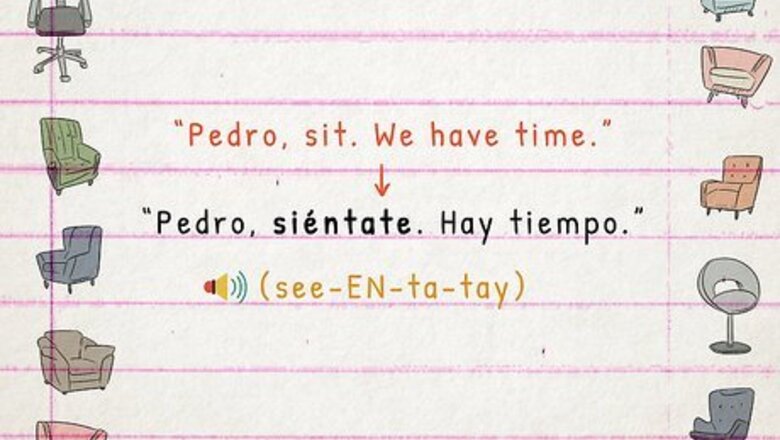
views
Using “Sentarse” (“To Sit”)

“Siéntate” (see-EN-ta-tay): “Sit!” (informal, singular) “Siéntate” is the informal command form of this verb, used when speaking to a single person (not a group of people). Use this form when speaking to someone with whom you’re close, or someone who is your age or younger. The verb “sentarse” is reflexive, which is why it has suffixes like “-se” or “-te.” This just means that the suffix changes form along with the verb. “Sentarse” is reflexive because it literally means “to seat oneself.” Sample sentence: “Pedro, siéntate. Hay tiempo.”Translation: “Pedro, sit. We have time.”
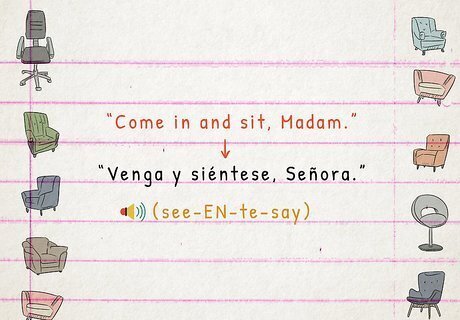
“Siéntese” (see-EN-te-say): “Sit!” (formal, singular) Use this variation of “siéntate” when speaking to someone formally. If you’re talking to someone to whom you’d like to show respect, like an older or respected person, this is a great alternative to use. Keep in mind that Spanish speakers tend to be relaxed about formal vs. informal distinctions. If you use the informal accidentally, it’s unlikely to offend someone. Sample sentence: “Venga y siéntese, Señora.”Translation: “Come in and sit, Madam.”

“Siéntense” (see-EN-ten-say): “Sit!” (informal or formal, plural) “Siéntense” should be used when speaking to a group of people. This is the plural form of the command in Latin America, and although it comes off as a little formal in Spain, it’s still widely understood. Sample sentence: “Escuchen, todos, siéntense donde gusten.”Translation: “Listen, everybody, sit wherever you’d like.”

“Sentaos” (see-EN-ta-os): “Sit!” (informal, plural) If you’re in Spain, use this version of the command when speaking to a group of people informally (close friends or people your age or younger). In Latin America, there is no distinction between informal and formal Spanish when talking to multiple people at once. Sample sentence: “Por favor, sentaos ahi, jovenes.”Translation: “Please sit down over there, young men.”
Using “Tomar Asiento” (“To Take a Seat”)
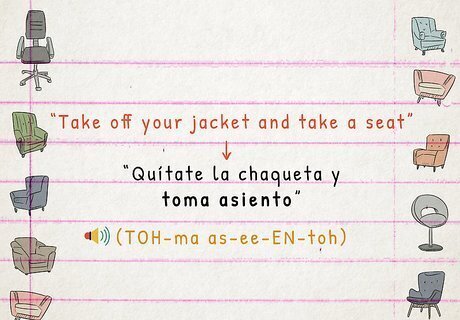
“Toma asiento” (TOH-ma as-ee-EN-toh): “Take a seat!” (informal, singular) Use this expression when you want to tell a single person to take a seat. As the informal version of this command, it’s best used when speaking to someone with whom you’re close, or who is your age or younger. This expression can be broken down into 2 parts: “tomar,” which means “to take,” and “asiento,” meaning, “seat.” Sample sentence: “Quítate la chaqueta y toma asiento.”Translation: “Take off your jacket and take a seat.”
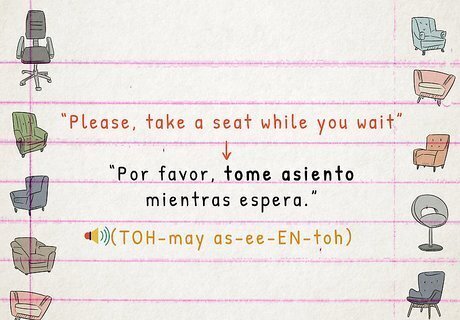
“Tome asiento” (TOH-may as-ee-EN-toh): “Take a seat!” (formal, singular) This is a formal alternative for “toma asiento,” which you can use when trying to show respect. This is a singular imperative form, so only use it when speaking to one other person. Sample sentence: “Por favor, tome asiento mientras espera.”Translation: “Please, take a seat while you wait.”

“Tomen asiento” (TOH-men as-ee-EN-toh): “Take a seat!” (informal or formal, plural) Use this command when speaking with multiple people formally in Spain, or in Latin America, when speaking with multiple people either informally or formally. Sample sentence: “Vamos, chicos, tomen asiento.”Translation: “Come on, guys, have a seat.”
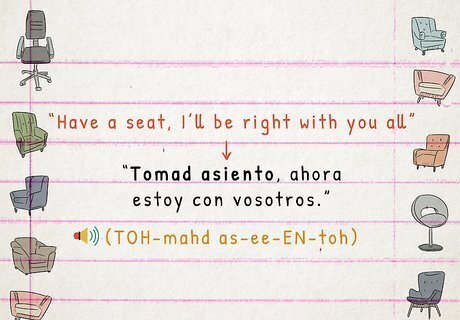
“Tomad asiento” (TOH-mahd as-ee-EN-toh): “Take a seat!” (informal, plural) If you’re in Spain, use this version of the command when speaking to multiple people informally. It’s also okay to simply say “Tomen asiento” in Spain, like you would in Latin America—you’ll be understood either way. Sample sentence: “Tomad asiento, ahora estoy con vosotros.”Translation: “Have a seat, I’ll be right with you all.”
Useful Phrases about Sitting

“¿Quieres sentarte?” (KYE-res sen-TAR-tay): “Would you like to sit?” This question is a polite way of asking someone if they’d like to get off their feet. You’re likely to hear it when visiting someone’s home or office. For a more formal variation, try “¿Quiere sentarse?” When speaking with multiple people, you can say “¿Quieren sentarse?” If you’d prefer to use “tomar asiento,” you can say “¿Quieres tomar asiento?” (informal, talking to one person)/“¿Quiere tomar asiento?” (formal, talking to one person)/“¿Quieren tomar asiento?” (informal or formal, talking to multiple people).
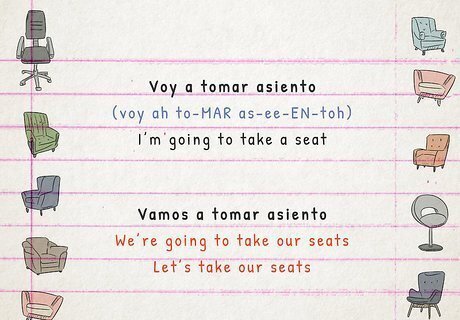
“Voy a tomar asiento.” (voy ah to-MAR as-ee-EN-toh): “I’m going to take a seat.”This sentence is useful if you want to talk about sitting in the future tense. You might want to use it to let people know where you’re going, or even invite them to sit with you. If you’re in a group of people, you can also say “Vamos a tomar asiento,” which means “We’re going to take our seats” or “Let’s take our seats.” If you’d rather use “sentarse,” you can also say “Me voy a sentar” or “Nos vamos a sentar.”
Talking about Sitting in the Present Tense

Conjugate “sentarse” in the present tense to form useful, descriptive sentences. We’ll go through all of the ways to use sentarse in the present indicative tense here, so that you can make your own sentences: Sample sentence: “Me siento en el cafe.”Translation: “I’m sitting in the cafe.” Sample sentence: “Si te sientas conmigo, podríamos cenar juntos.”Translation: “If you sit with me, we could dine together.” Sample sentence: “Normalmente se sienta aquí.”Translation: “He/she normally sits here.” Sample sentence: “Nos sentamos juntos en al avión.”Translation: “We sit together in the airplane.” Sample sentence: “¿Por qué no os sentaís?”Translation: “Why don’t you all sit down?” (only used in Spain) Sample sentence: “Todas las chicas se sientan ahí.”Translation: “All the girls sit there.”
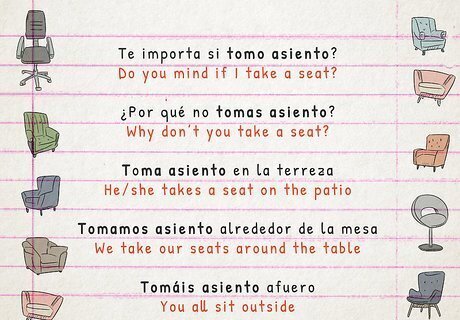
Practice conjugating “tomar asiento” in the present to master other verbs. “Tomar” is an “-ar” type Spanish verb, like “sentarse,” but without the reflexive ending. Mastering the normal “-ar” conjugation allows you to work with a ton of other verbs. Here are all the ways to use tomar asiento in the present indicative tense: Sample sentence: “¿Te importa si tomo asiento?”Translation: “Do you mind if I take a seat?” Sample sentence: “¿Por qué no tomas asiento?”Translation: “Why don’t you take a seat?” Sample sentence: “Toma asiento en la terreza.”Translation: “He/she takes a seat on the patio.” Sample sentence: “Tomamos asiento alrededor de la mesa.”Translation: “We take our seats around the table.” Sample sentence: “Tomáis asiento afuero.”Translation: “You all sit outside.” (only used in Spain) Sample sentence: “Si todos toman asiento, podremos empezar.”Translation: “If everyone takes their seats, we’ll be able to get started.”




















Comments
0 comment